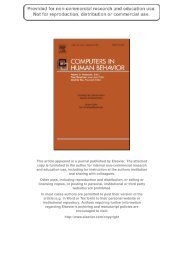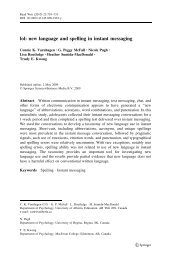Six Models for the Internet + Politics
Create successful ePaper yourself
Turn your PDF publications into a flip-book with our unique Google optimized e-Paper software.
Archon Fung, Hollie Russon Gilman, and Jennifer Shkabatur 31<br />
disagree, however, about <strong>the</strong> significance and character of that trans<strong>for</strong>mation.<br />
In particular, in one pole of this disagreement are those who approach <strong>the</strong> question<br />
steeped in <strong>the</strong> culture and perspective of <strong>the</strong> OpenSource community.<br />
Many of <strong>the</strong> pioneers of understanding <strong>the</strong> distinctive dynamics of new digital<br />
media plat<strong>for</strong>ms—social media and collaborative production—are quite optimistic<br />
about <strong>the</strong> potential <strong>for</strong> <strong>the</strong> <strong>Internet</strong> to dramatically increase <strong>the</strong> quality of<br />
democratic governance. We’re thinking here of scholars such as Yochai Benkler,<br />
Clay Shirky, and Beth Noveck. 2 On <strong>the</strong> o<strong>the</strong>r hand, some political scientists who<br />
have examined actual patterns of political activity and expression on digital plat<strong>for</strong>ms<br />
come away skeptical that ICT plat<strong>for</strong>ms will bring equality or inclusion to<br />
democratic politics. 3<br />
In this article, we contribute to this debate by offering six different possible<br />
models of interaction between ICTs and politics. These models all begin from a<br />
highly stylized image of political decision making through citizens, interest<br />
groups, and governments. 4 Then, we place ICTs at different points in this<br />
model—reflecting positions found in various arguments in <strong>the</strong> digital politics literature—and<br />
reason about whe<strong>the</strong>r or not that placement is a sensible way to<br />
consider <strong>the</strong> role of ICT in politics and what <strong>the</strong> effects of ICT on politics might<br />
be. We use several empirical case studies of <strong>the</strong> use of ICTs in accountability<br />
politics to illustrate some of <strong>the</strong>se models. We do not mean <strong>the</strong>se models to be<br />
exclusive or fully comprehensive. Ra<strong>the</strong>r, <strong>the</strong>y capture some of <strong>the</strong> ways in<br />
which ICTs intervene with and affect political systems.<br />
The aims of this article are twofold. First, we develop a more clear understanding<br />
of <strong>the</strong> emerging interactions between ICT and governance by taking<br />
both <strong>the</strong> perspectives from technologists and from scholars of politics seriously<br />
at <strong>the</strong> same time. As we have said, scholars who live on “technology street”<br />
tend to be optimists about <strong>the</strong> trans<strong>for</strong>mative possibilities of ICTs <strong>for</strong> democracy.<br />
Those living on “political science street” tend to be quite skeptical<br />
because <strong>the</strong>y think technology optimists are inattentive to <strong>the</strong> mainsprings of<br />
politics: interests and institutions. As a result, <strong>the</strong> two sides talk past one<br />
ano<strong>the</strong>r. Each, <strong>the</strong> o<strong>the</strong>r thinks, just doesn’t “get it.” This article works right at<br />
<strong>the</strong> intersection—taking insights into both seriously and locating a truth that is<br />
in-between claims that <strong>the</strong> whole world is different and that nothing new is<br />
under <strong>the</strong> sun. These models enact that interdisciplinarity by beginning with a<br />
simple institutional schematic that is familiar to any scholar of politics (but not<br />
to technology scholars). We <strong>the</strong>n reason about <strong>the</strong> likely effects of ICT by<br />
locating different kinds of digital interventions that take seriously <strong>the</strong> new<br />
dynamics of digital communication (e.g., lowered communication costs and<br />
self-organizing possibilities, crowd sourcing, collaborative production, many-tomany<br />
and asynchronous communications) that ICT scholars emphasize, but<br />
that are less familiar to political analysts. Second, we hope that <strong>the</strong>se models<br />
will provide useful mental maps <strong>for</strong> scholars and practitioners that will help<br />
<strong>the</strong>m to locate just how some digital intervention or application fits into <strong>the</strong><br />
larger institutional panoply of a political system with its own barriers and competing<br />
pressures.<br />
This article’s organization is straight<strong>for</strong>ward. The next section begins with a<br />
simple model of politics. The six sections after that describe six different locations<br />
of ICT intervention in that political system. The first three suppose fundamental<br />
reorganizations of <strong>the</strong> political model, whereas <strong>the</strong> second three describe<br />
incremental contributions of ICT. We argue that we are less likely to see ICT<br />
2<br />
Benkler (2006); Shirky (2008); Noveck (2009). But <strong>for</strong> a counterpoint, see Morozov (2011).<br />
3<br />
Hindman (2009); Schlozman, Verba and Brady (2012, pp. 483–534).<br />
4<br />
In this article, our stylized scheme models politics principally within democratic societies. We hope to extend<br />
this treatment to cover international dynamics and nondemocratic societies on a later occasion.
















